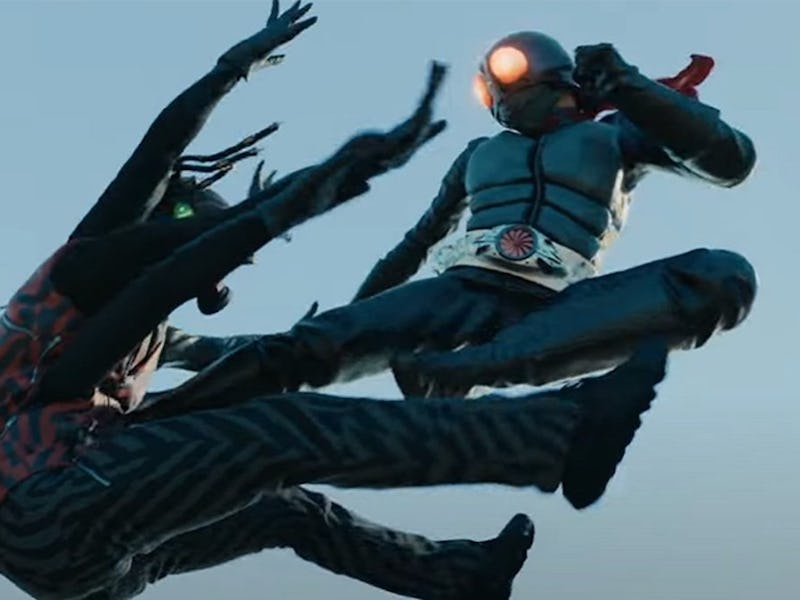A Throwback Japanese Tokusatsu Movie Outpaces All Other Superheroes This Year
He's a masked rider!

Hideaki Anno, in some way or another, has spent most of his career trying to live up to his first masterpiece, Neon Genesis Evangelion. A towering work of cerebral sci-fi, Evangelion juggled its mecha-anime narrative with Freudian character drama, bureaucratic nightmares, cosmic terror, and extremely horny teen angst. It’s one of the most thematically dense works of the 20th century, and it’s no wonder Anno has spent the years since its release funneling its disparate elements through other works of art.
The Rebuild Evangelion series is the obvious answer, but you also see Evangelion’s bureaucratic malaise in the superb Shin Godzilla, and the wacky mecha antics (combined with more bureaucratic twists) in Shin Ultraman. Now, in the film closing out his Shin tetralogy, Shin Kamen Rider seems ripe for the same kind of Evangelion remix. But instead, this pulpy throwback of a superhero movie feels like nothing Anno has ever done.
Shin Kamen Rider (titled Shin Masked Rider in its U.S. digital release), is a modern remake of Kamen Rider, one of the most beloved tokusatsu superheroes in Japanese culture. Created in the ‘70s, Kamen Rider follows college student Takeshi Hongo on his quest to defeat the world-conquering SHOCKER organization, which transforms humans into brainwashed synthetic animal hybrids known as Augments, or Augs. The original Kamen Rider series was a huge sensation, spawning TV and film sequels and, alongside Super Sentai, is credited with launching the Second Kaiju Boom on Japanese television.
Kamen Rider is less known in the U.S. than its counterpart Super Sentai, which would become the basis for the mammoth franchise Power Rangers. Maybe the bug mask and abilities don’t translate well to the West (he’s got the powers of a grasshopper!), or maybe American viewers can only take one tokusatsu franchise at a time. But even with a baseline understanding of how Japanese superheroes work, Kamen Rider is a weird, deranged blast.
The movie begins with our future Kamen Rider, Takeshi Hongo (Sosuke Ikematsu), being kidnapped by SHOCKER, which transforms him into an Augment with the power of a grasshopper. But before the sinister organization can brainwash him, he’s set free by Ruriko Midorikawa (Minami Hamabe), a former SHOCKER member intent on bringing them down. Inspired by Ruriko’s steely determination, Takeshi takes on the mantle of Kamen Rider, a vigilante who pledges to protect the world from SHOCKER.
Double rider!!!
The plot is simple, though its various twists get annoyingly convoluted (Ruriko has an evil brother, and AI might be involved?). But the plot isn’t the important part of Shin Kamen Rider. It’s Anno, as director, writer, concept designer, costume designer, and co-editor, using everything he never got to show off in Neon Genesis Evangelion and its various offshoots. Anno flexes his horror muscles in the frantic opening scene, with terrifying distorted camera angles and freaky body horror. Shin Kamen Rider is by far his pulpiest film, but it’s also his most charmingly nostalgic. The film is made in homage to the Showa era that birthed the franchise, and it shows in its schlocky horror and campy fight scenes.
But even with its low-budget charm, Shin Kamen Rider is more visually impressive than many big-budget superhero movies. It’s all whip pans, fast zooms, and rapid cuts. Even its fight scenes, clearly made with miniature models, have tremendous charm. Shin Kamen Rider proves the tokusatsu genre is thriving in Japan, providing fresh air as we’re further inundated with more middling Marvel movies in the West. Perhaps the Shin movies aren’t an answer to superhero fatigue, but at least they’re a fun wake-up call.